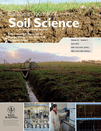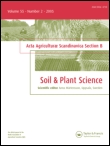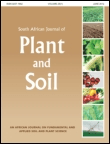
PEDOSPHERE
Scope & Guideline
Empowering Knowledge for Global Soil Challenges
Introduction
Aims and Scopes
- Soil Health and Sustainability:
Research on soil health emphasizes the roles of soil microorganisms, organic matter, and management practices in maintaining soil fertility and ecosystem services. - Pollution and Remediation:
The journal addresses the impact of pollutants such as heavy metals, pesticides, and microplastics on soil health and explores bioremediation and phytoremediation strategies. - Nutrient Dynamics:
Studies on nutrient cycling—including nitrogen, phosphorus, and carbon—investigate the effects of different agricultural practices and amendments on soil nutrient availability and plant uptake. - Soil-Plant-Microbe Interactions:
Research highlights the interactions between soil microbes and plants, including mycorrhizal associations and their impact on plant health and productivity. - Climate Change Effects:
The journal examines how climate change influences soil properties and processes, including greenhouse gas emissions, soil moisture, and temperature dynamics. - Soil Physics and Hydrology:
Investigations into soil physical properties and hydrological processes focus on water retention, infiltration, and erosion, contributing to improved soil management practices.
Trending and Emerging
- Microbial Ecology and Functionality:
There is an increasing focus on understanding microbial community dynamics and their functional roles in soil health, particularly in relation to sustainability and resilience in agricultural systems. - Bioremediation Techniques:
Research on innovative bioremediation techniques, including the use of biochar, nanomaterials, and phytoremediation strategies, is gaining momentum as a solution to soil contamination. - Impact of Climate Change on Soil Processes:
Emerging studies are examining how climate change affects soil processes, including carbon cycling, greenhouse gas emissions, and the resilience of soil ecosystems. - Soil Amendments and Fertility Enhancements:
The use of organic amendments, such as compost and biochar, is increasingly being researched for their role in enhancing soil fertility and health. - Precision Agriculture and Soil Management:
The integration of precision agriculture technologies in soil management practices is a growing trend, focusing on optimizing input use and improving soil health. - Soil Health Indicators and Assessment:
There is a rising interest in developing and validating soil health indicators that can effectively assess soil condition and inform management practices.
Declining or Waning
- Soil Toxicology Studies:
Research specifically focused on soil toxicology has become less prominent, possibly due to a broader integration of toxicological assessments within studies on pollution and remediation. - Traditional Soil Fertility Management:
There appears to be a waning interest in conventional soil fertility management practices, as newer methodologies and sustainable approaches gain traction. - Historical Soil Studies:
Papers focusing on historical soil studies and archeological soil analysis have decreased, indicating a shift towards contemporary and applied soil research.
Similar Journals

EGYPTIAN JOURNAL OF SOIL SCIENCE
Innovating Practices for a Greener TomorrowEGYPTIAN JOURNAL OF SOIL SCIENCE is a renowned publication dedicated to advancing the field of soil science, particularly within the context of Egypt and the broader regions of the Middle East and North Africa. Published by the NATIONAL INFORMATION DOCUMENTATION CENTER, ACADEMIC SCIENTIFIC RESEARCH & TECHNOLOGY, this journal aims to disseminate high-quality research and innovative practices related to soil management, conservation, and sustainable agricultural practices. With an emphasis on empirical studies, reviews, and methodologies relevant to soil health and productivity, this journal serves as an essential resource for researchers, professionals, and students alike. Although specific access options are not highlighted, the journal’s commitment to promoting scholarly discourse ensures that important findings within soil science are made available to wider audiences, contributing significantly to environmental science, agronomy, and ecological preservation.

Frontiers in Soil Science
Bridging research and practice in soil health.Frontiers in Soil Science, published by FRONTIERS MEDIA SA in Switzerland, is an esteemed open-access journal dedicated to advancing our understanding of soil systems and their vital role in ecosystem functioning and sustainable agricultural practices. Since its inception in 2021, this journal has quickly established itself within the scientific community, boasting a 2023 Scopus Q2 ranking in Soil Science and a notable percentile of 41 among its peers. Researchers and practitioners in the field will find a wide array of original research, reviews, and contributions that address key topics such as soil health, carbon sequestration, and nutrient cycling. With a commitment to fostering collaboration and dissemination of knowledge, Frontiers in Soil Science serves as a vital resource for professionals, researchers, and students who aspire to innovate and lead in soil science research.

JOURNAL OF PLANT NUTRITION AND SOIL SCIENCE
Empowering researchers to cultivate excellence in agriculture.JOURNAL OF PLANT NUTRITION AND SOIL SCIENCE, published by WILEY-V C H VERLAG GMBH, stands as a premier platform in the field of agricultural and biological sciences, focusing specifically on the intricacies of plant nutrition and soil science. With an impressive impact factor and a respected Q1 category ranking in Plant Science and Q2 category ranking in Soil Science for 2023, this journal is essential for researchers and professionals seeking to advance their understanding and foster innovative practices in sustainable agriculture. The journal’s open access options ensure a broad dissemination of knowledge, appealing to a global audience and facilitating collaborative research efforts. Embracing a broad scope that extends from foundational science to cutting-edge research developments in soil health and nutrient management, the journal serves as a critical resource for both emerging scholars and established experts, reinforcing its pivotal role in addressing the challenges of food security and environmental sustainability. With years of convergence from 1996 to 2024, it remains committed to excellence in scholarly communication, providing a vital forum for the sharing of valuable insights and advancements in the field.

EUROPEAN JOURNAL OF SOIL SCIENCE
Connecting Science to Soil Sustainability ChallengesEUROPEAN JOURNAL OF SOIL SCIENCE, published by Wiley, stands as a leading platform in the field of soil science, recognized for its contributions to the understanding of soil ecology, management, and sustainability. With an impressive impact factor and a distinguished Q1 ranking in Soil Science, this journal has recently ranked 23rd out of 159 in its category on Scopus, placing it in the 85th percentile among its peers. Covering a wide array of topics as it converges into the future, from 1994 to 2024, the journal aims to disseminate groundbreaking research and innovative methodologies that address the pressing challenges of soil degradation and environmental sustainability in Europe and beyond. Although it is not an open access journal, the EUROPEAN JOURNAL OF SOIL SCIENCE remains a vital resource for researchers, professionals, and students seeking to deepen their understanding and explore the latest advancements in soil science.

Soil Science Annual
Cultivating innovative research in soil science.Soil Science Annual, published by Polskie Towarzystwo Gleboznawc, is an esteemed open-access journal dedicated to advancing the field of soil science and related disciplines. With its ISSN 2300-4967 and E-ISSN 2300-4975, this journal has been pivotal since its inception in 2012, providing a vital platform for researchers, professionals, and students to share innovative findings and insights. The 2023 Scopus rankings place the journal in Q2 for Earth and Planetary Sciences (miscellaneous), and Q3 for both Environmental Science (miscellaneous) and Soil Science, underscoring its influence and contribution to these fields. Housed in Warsaw, Poland, the journal fosters scholarly dialogue and dissemination of research findings critical to understanding soil mechanics, conservation practices, and sustainable land use. With its open-access model, Soil Science Annual ensures that research is accessible to a broad audience, encouraging collaboration and innovation in tackling global environmental challenges.

JOURNAL OF SOILS AND SEDIMENTS
Pioneering Research in Soil and Sediment InteractionsJOURNAL OF SOILS AND SEDIMENTS, published by SPRINGER HEIDELBERG, stands as a premier interdisciplinary platform dedicated to advancing the understanding of soil and sediment dynamics within the broader context of Earth sciences. With an impressive impact factor and a Q1 ranking in both Earth-Surface Processes and Stratigraphy, this journal not only reflects the high quality of research but also contributes significantly to the dialogue amongst researchers, professionals, and students in the field. The journal encompasses a wide spectrum of topics from sedimentology to soil science, making it essential reading for those involved in environmental management, agriculture, and geology. Access options are available to ensure that cutting-edge research is accessible to a global audience, reflecting the journal's commitment to fostering collaboration and innovation. As we converge towards 2024, JOURNAL OF SOILS AND SEDIMENTS aims to continue its role in shaping scientific inquiry and policy formulation concerning the vital roles of soils and sediments in ecological and geological systems.

ACTA AGRICULTURAE SCANDINAVICA SECTION B-SOIL AND PLANT SCIENCE
Transforming Research into Real-World Agricultural SolutionsACTA AGRICULTURAE SCANDINAVICA SECTION B-SOIL AND PLANT SCIENCE, published by Taylor & Francis AS, is a distinguished journal dedicated to the fields of Agronomy, Crop Science, and Soil Science. With an impressive impact factor, and categorized in Q2 for both Agronomy and Crop Science and Soil Science as of 2023, this journal is an essential resource for researchers, professionals, and students aiming to advance their understanding of soil-plant interactions and sustainable agricultural practices. Operating since 1992 and continuing through to 2024, ACTA aims to publish high-quality, peer-reviewed research that encourages the applicability of advanced scientific knowledge in real-world agricultural settings. While the journal is not open access, it remains widely accessible through institutional subscriptions, reflecting its commitment to disseminating essential findings and fostering innovation in soil and plant science worldwide. Nestled in the vibrant academic environment of Norway, ACTA AGRICULTURAE SCANDINAVICA serves as a key platform for nurturing groundbreaking research that informs sustainable agricultural policies and practices globally.

Soil Ecology Letters
Advancing the Frontiers of Soil ScienceSoil Ecology Letters, published by SpringerNature, is a premier journal dedicated to advancing the knowledge and understanding of soil ecosystems, their functions, and their vital role in global sustainability. Since its inception in 2019, this leading journal has consistently maintained its prestigious Q1 ranking in Ecology, Evolution, Behavior and Systematics, as well as Soil Science, reflecting its significant impact in the ecological and environmental sciences community. With an impressive Scopus ranking that places it within the top percentile of journals in its field, Soil Ecology Letters provides a platform for researchers and professionals to disseminate their groundbreaking findings. The journal is a vital resource for advancing research in agricultural and biological sciences, offering open access options that promote widespread dissemination of knowledge. With its focus on fostering collaboration and innovation in soil ecology, this journal is essential reading for anyone aiming to deepen their understanding of soil environments and their critical role in ecological health.

Spanish Journal of Soil Science
Unlocking the Secrets Beneath Our FeetThe Spanish Journal of Soil Science is a prestigious open-access journal published by FRONTIERS MEDIA SA since 2011. Based in Switzerland, this journal serves as a vital platform for disseminating innovative research and applications within the field of soil science. With its commitment to accessibility, the journal enables researchers, professionals, and students from around the globe to contribute to and benefit from its wealth of knowledge. As of 2023, it holds a respectable Q3 category ranking in soil science and is positioned at #88 out of 159 in the Scopus rankings for Agricultural and Biological Sciences. The journal aspires to foster collaboration and communication among soil scientists, encouraging the exploration of contemporary soil issues, sustainable practices, and advancements in technology. Its open-access model ensures that the latest findings are freely available, promoting a broader impact in environmental and ecological studies.

South African Journal of Plant and Soil
Fostering knowledge for sustainable environmental solutions.South African Journal of Plant and Soil is an esteemed academic publication dedicated to advancing the fields of Ecology, Plant Science, and Soil Science. Published by TAYLOR & FRANCIS LTD in the United Kingdom, this journal has been a vital resource since its inception in 1984, providing a platform for innovative research and scholarly articles that address critical issues in plant and soil management. With a current impact factor placing it in the Q3 category according to the 2023 rankings, it occupies an influential position within the academic community, especially amongst researchers focused on agricultural and environmental sciences. Although not an open-access journal, it remains accessible to a broad audience through libraries and institutions that recognize its value in facilitating ecologically and environmentally focused discussions. The journal's ongoing commitment to publishing high-quality research ensures that it plays a pivotal role in nurturing knowledge and fostering advancements in sustainable practices across southern Africa and beyond.